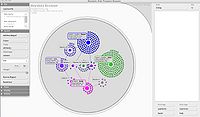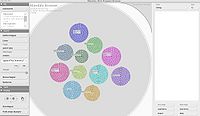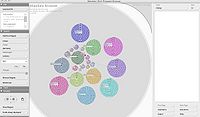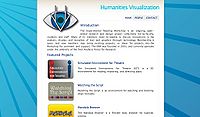CIRCA:Mandala Browser Project
From CIRCA
Contents |
Summary
The Mandala Browser Project is a circular interface that lets people (specifically those in academia) use visual Boolean searching on electronic XML tagged documents. It is classified as an example of rich prospect browsing, which is “…where a meaningful representation of each item in a collection serves as the basis for a set of tools for organizing those representations in useful ways” (Ruecker, 2). The actual term Mandala is from Hinduism and Buddhism, meaning a geometric shape that represents the universe (“Mandala Dictionary.com”). This SSHRC (Social Sciences and Humanities Research Council) funded Browser is part of the Humanities Visualization Project, lead by Stéfan Sinclair and Stan Ruecker (Reading Orlando with the Mandala Browser, 6), but the idea originated from Oksana Cheypesh (around 2006). By using and experimenting with Mandala, people can support or create new theories about documents.
Audience and Purpose
The Mandala Browser Project is a text analysis tool suited for academic pursuits. An article by Stéfan Sinclair and Stan Ruecker’s (et. all) supports this emphasis on using Mandala in schools. “Meditating on a Mandala in Class: Studying Shakespeare’s Plays with a visual exploration Tool for XML texts,” acts as an instruction manual for using the Mandala Browser. The article takes the reader through possible hypothesizes that students can find or support when using this tool. To encourage this interaction, the prototype has pre-loaded Shakespeare plays to let researchers practice on it The Audience broadens when considering the other applications for the technology. The Mandala website suggests that the browser would work with email systems, research data, image browsing, and University course descriptions. The Mandala browser can be applied to multiple databases and documents, increasing the size of the audience.Structure
Mandala is a circular visual interface that displays the results of a search. Before searching begins, the uploaded document sections are displayed as grey dots around the edge of the circle. In the case of the picture to the left, the dots represent the speeches of eleven of Shakespeare’s plays, but in novels, the dots could easily be paragraphs or chapters. The large blue dot in the center is called an axis, node or magnet (the term used for this wiki is magnet). The magnets attract the periphery dots when a search term is entered. The location of magnets does not mean anything (an algorithm determines the space between each magnet) and the same is said for the magnet colours, they are randomly assigned (Reading Orlando with the Mandala Browser, 9-10). You can designate colours for a magnets, it would be helpful to do so in instances were the search term is commonly related to a certain colour (like making a Democrat magnet blue, and a Republican one red). To read the speeches or paragraphs that the dots represent you can click on them, or to read many at the same time there are tools on the left toolbar that let the user highlight (with a circle, square, or “lasso” options) many dots. If one clicks on the grey dots you can see the XML tagging. There is a history area on the toolbar, where the user can go back to various stages of their searching. This represents one of Tognazzini’s rules of “Interaction Design” (First Principles of Interaction Design, Tognazzini). The browser is a well-organized and helpful text analysis tool.There are limitations to the Mandala browser, the article by Susan Brown (et. all) describe that the browser is “…dependent on several factors” (Reading Orlando with the Mandala Browser, 6-7). The browser depends on how well the text is marked up in XML (someone may tag the paragraphs in a novel but not the chapters. Users also need to know Boolean logic, eXtensible Markup Language, and understand that the Mandala Browser flattens out the tagging or XML hierarchy. If the user or the document fails so does the usefulness of Mandala.
Technology
Released in 1995, Java is a programming language and computer platform. It powers art programs like games, in this case, Java runs the Mandala Browser. The documents that Mandala depends on are electronically tagged texts. eXtensible Markup Language (XML) lets users mark up electronic documents with tags of information (like elements and attributes). XML is defined and produced by W3C, a consortium that controls much of the formatting of documents on the web (like web pages in HTML of XHTML). The Mandala Browser also reads PDF (Portable Document Format) and ASCII (American Standard Code for Information Interchange). The documents in the prototype are from a project at Northwestern University. Word Hoard is a collection of XML texts. The search engine used is Apache Lucene (written in Java). It is supported by the Apache Software Foundation (A free and open source software organization) and is released under the Apache Software License. The entire project is from Humanities Visualization. Founded in 2003 under TAPoR and it is an organization that discusses “…innovations in analysis, display, and reception of text and graphics through technology (“Humanities Visualization”).”
People
The Mandala website lists the people involved with this project. As mentioned before Oksana Cheypesh originally came up with the idea around 2006, Stéfan Sinclair and Stan Ruecker are in charge of the project.
- Directors: Stéfan Sinclair (McMasters University) and Stan Ruecker (University of Alberta)
- Concept and Design: Chris Vitas, Oksana Cheypesh (PhD student of Comparative Literature at the University of Alberta), Constanza Pacher, and Sandra Gabriele
- Development: Thomas Gwosdz, Matt Gooding, Bartosz Bajer, Matt Patey, Anthony Sapp, Drew Paulin, Johnny Rodgers.
Partners and Future
The Mandala Project is not yet live but some websites are collaborating with the project. An article, “Reading Orlando with the Mandala Browser: A case study in Algorithmic Criticism via Experimental Visualization,” discusses the possibilities that Mandala provides for websites that contain tagged text. The Mandala website lists the other partners of the browser. The future of Mandala is in these websites.
- Rêves.ca is a French website that contains a large compilation of texts about dreams from history.
- The Orlando Project is a huge electronic collection about the lives and works of British Women writers (and some male writers). All the documents are marked up using XML, making it a perfect place to use the Mandala Browser. With Mandala, you can investigate and compare the writer’s lives and works to investigate and support hypothesizes, much like what we did with Shakespeare.
Related Projects
- InfoCrystal is a search interface used as a visualization tool. It lets users see Boolean searches graphically. It was created in 1995 at MIT as part of the research and thesis of a PhD student (Anselm Spoerri).
- TextArc shows the entire text twice on a circular disc, highlighting the emphasized words. The website describes it as “…a combination of an index, concordance, and summary; it uses the viewer's eye to help uncover meaning.” (“TextArc.org Home”)
- TAPoR (Text Analysis Portal for Research)
References
Brown, Susan, Stan Ruecker, Jeffery Antoniuk, Sharon Balazs, Matt Gooding, Stéfan Sinclair, Matt Patey, and Sandra Gabriele. “Reading Orlando with the Mandala Browser: A Case Study in Algorithmic Criticism via Experimental Visualization.” Pre-Publication.
“Humanities Visualization.” Web. 1 Nov. 2010.
“Mandala | Define Mandala at Dictionary.com.” Web. 1 Nov. 2010.
“Mandala: Rich Prospect Browser.” Web. 1 Nov. 2010.
Ruecker, Stan. “Experimental Interfaces Involving Visual Grouping During Browsing.” Partnership: the Canadian Journal of Library and Information Practice and Research 1.1 (2006): n. page. Web. 3 Nov. 2010.
Ruecker, Stan. “Experimental Interfaces Involving Visual Grouping During Browsing.” Partnership: the Canadian Journal of Library Information Practice and Research. 1.1 (2006).
Sinclair, Stéfan, Stan Ruecker, Sandra Gabriele, Matt Patey, Matt Gooding, Chris Vitas, and Bartosz Bajer. “Mediating on a Mandala in Class: Studying Shakespeare’s Plays with a Visual Exploration Tool for XML Texts.” Pre-Publication.
“TextArc.org Home.” Web. 1 Nov. 2010.
Tognazzini, Bruce. “AskTog: First Principles of Interaction Design.” Web. 27 Oct. 2010.








